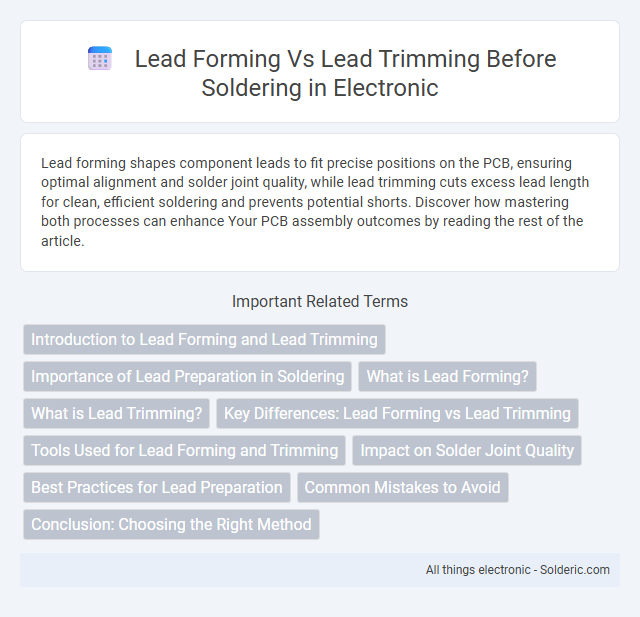Lead forming shapes component leads to fit precise positions on the PCB, ensuring optimal alignment and solder joint quality, while lead trimming cuts excess lead length for clean, efficient soldering and prevents potential shorts. Discover how mastering both processes can enhance Your PCB assembly outcomes by reading the rest of the article.
Comparison Table
| Aspect | Lead Forming | Lead Trimming |
|---|---|---|
| Definition | Bending component leads to fit PCB holes before soldering | Cutting leads to desired length after insertion, before soldering |
| Purpose | Ensure proper alignment and fit of components on PCB | Remove excess lead length for neatness and solder joint quality |
| Process Timing | Before component insertion into PCB | After component insertion, before soldering |
| Impact on Assembly | Aids in stable component placement | Prevents solder bridges and shorts |
| Tools Used | Lead forming tools, bending jigs | Trimming cutters, snips |
| Benefits | Improves component fit, reduces mechanical stress | Ensures clean solder joints, reduces defects |
Introduction to Lead Forming and Lead Trimming
Lead forming shapes electronic component leads to precise configurations that ensure proper fit and alignment on printed circuit boards (PCBs). Lead trimming involves cutting excess lead length to prevent shorts and enhance solder joint reliability during assembly. Both processes are critical for maintaining component integrity and ensuring optimal soldering quality in PCB manufacturing.
Importance of Lead Preparation in Soldering
Proper lead preparation is crucial in soldering to ensure strong mechanical connections and optimal electrical conductivity. Lead forming shapes the leads to fit precisely into PCB holes or onto surface mount pads, while lead trimming removes excess lead length to prevent shorts and ensure efficient heat transfer during soldering. Your careful lead forming and trimming directly impact solder joint reliability and overall circuit board performance.
What is Lead Forming?
Lead forming involves shaping component leads to fit specific circuit board layouts before soldering, ensuring proper alignment and mechanical stability. This process prevents damage during assembly and improves solder joint quality by positioning leads accurately according to PCB hole placements. By carefully forming your leads, you enhance the overall reliability and performance of the electronic assembly.
What is Lead Trimming?
Lead trimming is the process of cutting component leads to the appropriate length before soldering to ensure proper fit and optimal electrical connections on a printed circuit board (PCB). This step is essential to prevent short circuits and improve the reliability of the solder joint by removing excess lead material that might interfere with the assembly. Proper lead trimming enhances the stability of the component placement, facilitating efficient solder flow and stronger mechanical bonds.
Key Differences: Lead Forming vs Lead Trimming
Lead forming reshapes component leads to fit specific PCB hole patterns, ensuring proper alignment and mechanical stability, while lead trimming cuts excess lead length to prevent solder bridging and improve electrical performance. Lead forming is typically performed before lead trimming to maintain lead integrity during insertion. Effective sequencing of lead forming before trimming enhances solder joint quality and overall assembly reliability.
Tools Used for Lead Forming and Trimming
Lead forming typically employs specialized lead forming machines or manual pliers to bend component leads into precise shapes for proper PCB insertion, ensuring accurate lead alignment and preventing damage. Lead trimming uses high-precision lead cutters, such as pneumatic trimmers or rotary cutters, designed to remove excess lead length cleanly and consistently before soldering, improving solder joint quality. Choosing the right tools for your lead forming and trimming processes enhances assembly efficiency and solder reliability.
Impact on Solder Joint Quality
Lead forming before soldering ensures proper alignment and uniform contact between the component leads and PCB pads, which enhances solder joint reliability and reduces the risk of cold solder joints. Lead trimming after soldering can cause mechanical stress on the freshly formed solder joints, potentially leading to cracks or weakened connections. Optimizing lead forming prior to soldering significantly improves solder joint quality by promoting consistent heat transfer and improved metallurgical bonding.
Best Practices for Lead Preparation
Lead forming ensures optimal component alignment and mechanical stability before soldering, while lead trimming removes excess lead length to prevent bridging and improve solder joint reliability. Best practices include precise measurement of lead length after forming to match PCB pad designs and using appropriate tools to avoid damaging the leads or component body. Consistent inspection and adherence to manufacturer specifications minimize defects, ensuring robust electrical connections and long-term assembly performance.
Common Mistakes to Avoid
Lead forming and lead trimming before soldering require precise handling to avoid damaging component leads or creating poor solder joints. Common mistakes include over-bending leads, which can cause fractures, and trimming too close to the component body, increasing the risk of mechanical stress or unreliable connections. You should maintain proper lead length and angle to ensure optimal mechanical strength and solder joint quality.
Conclusion: Choosing the Right Method
Lead forming ensures precise shaping and alignment of components for optimal solder joint reliability, while lead trimming focuses on removing excess lead length to prevent shorts and fit compact PCBs. Your choice depends on the assembly requirements: use lead forming when precise lead positioning is critical, and lead trimming when space constraints and clean board layout are priorities. Both methods enhance soldering quality but address different aspects of lead preparation for effective electronic assembly.
Lead forming vs lead trimming before soldering Infographic

 solderic.com
solderic.com